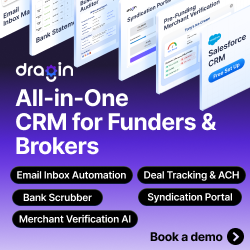Industry News
Strategic Funding Source Integrates U.S. Operations of Capify
January 4, 2017New York, NY – Strategic Funding Source, Inc., today announced that it has entered into an agreement to integrate the United States operations of Capify into its adaptive proprietary operating platform. Both Strategic Funding and Capify have been providing non-bank financing options to small and mid-size businesses for over a decade. This integration enables Strategic Funding to expand its US operations by marketing to and providing capital to existing Capify customers who will, upon renewal of existing merchant cash advances or business loans, become part of the Strategic Funding family of customers.
“We are very pleased to have put together a deal with Strategic Funding that will provide our customers a future source of important capital. As a company that shares our values of providing simple, transparent and responsible access to capital for small and mid-sized businesses, it was a logical transition,” said David Goldin, Founder and CEO of Capify.
As part of the transition, many of Capify’s New York-based employees will become part of the larger and growing family of employees at Strategic Funding. The transition also allows Capify’s existing U.S. clients and partners the opportunity to take advantage of a larger variety of financing options, while still benefitting from the same standards of transparency and integrity that they have come to expect from Capify.
“It is rare that two companies in the same industry can come together and craft a synergistic deal that serves the best interests and strategies of each – but this integration does just that,” stated, Andy Reiser, CEO of Strategic Funding. “We have been friends of David and Capify for many years and have collaborated on and co-invested in the financing of many businesses over the years. We share the same focus on technology and quality underwriting that our customers, partners and the financial industry have come to expect from us. This transaction only strengthens the relationship between the two organizations”
ABOUT STRATEGIC FUNDING
Founded in 2006 and headquartered in NYC, Strategic Funding has been recognized by customers and the industry as one of the most reliable and respected names in small business financing. With flexible financing options, we have provided over 35,000 small businesses with the working capital they needed to take advantage of opportunities and grow. To learn more, visit www.sfscapital.com
Platinum Rapid Funding Group Originated $180 Million in 2016
January 3, 2017A social media post by Platinum Rapid Funding Group CEO Ali Mayar, revealed that the Long Island-based company had originated $180 million in deal flow in 2016. That’s almost twice their 2015 volume, and is a new record for the company.
In Mayar’s post, he wrote, “Thank you to everyone who’s a part of this unstoppable organization for an amazing year and the best is yet to come.”

deBanked’s Top 10 Most Read Stories of 2016
December 28, 2016
If 2015 was the year of the broker, well then 2016 was the year of readjusted expectations. The following are the top 10 most read stories of 2016 per our online analytics, some of which surprised even us. Either way, here’s what you read and shared on our website the most in 2016 in descending order:
10: Do Bank Statements Matter in Lending? Business Lenders and Consumer Lenders Disagree
A 2015 story, it was the 10th most read in 2016. One thing the lending revolution has taught us is that a borrower’s bank statements can mean everything or nothing at all.
9: Should I start an ISO with only $2,000?
Even though this was published two full years ago, it managed to be the 9th most read story of 2016. The short answer to this question is no, don’t start an ISO with such a small budget especially not in 2016 or 2017.
8: Lending Club Class Action Lawsuit Predicated on Madden v Midland Risk
A big story early in the year was Madden v Midland, and the impact an appellate court ruling could have on marketplace lenders who rely on chartered banks to make loans for them in 50 states. This particular post and related ones attracted a lot of readers in 2016.
7: Business Loan Brokers and MCA ISOs Call it Quits
For the first time ever, brokers and ISOs began to say farewell to an industry faced with oversaturation.
6: Merchant Cash Advance Accounting – A How To Guide
Published two full years ago, the merchant cash advance accounting guide managed to be the 6th most read article on deBanked in 2016. The article is meant for MCA funders bookkeeping, not for merchants who use merchant cash advances.
5: Lending Club Borrowers Are Paying Off Really Early – And There’s Something Weird About It
Lending Club’s loan borrowers pay off their loans early at a freakish level. I pondered this in a blog post in February and the trend has not changed. To date, I’ve had 975 borrowers pay off early, nearly double since the time this was published.
4: Platinum Rapid Funding Group Sets Annual Funding Record
An astounding amount of visitors were interested in Platinum Rapid Funding Group’s 2015 origination volume. An announcement that the company had originated $100 million in deals was the 4th most read story of 2016.
3: Merchant Cash Advance Definitely NOT a Loan, New York Judge Rules
Yet another post referencing Platinum Rapid Funding Group, was a decision issued in a New York trial court. In it, a judge opined at length about the nature of purchasing future receivables.
2: Shakeup at CAN Capital – CEO and 2 other Execs Put on Leave of Absence
Despite being less than a month old, this story on its own was the 2nd most read of 2016, technically followed by this one and this one, both also about CAN’s recent issues. We combined them into one story for the purpose of this list since they were all related to the same event.
1: The Closer – Meet the Yellowstone Capital Rep That Originated $47 Million in Deals Last Year
The #1 most read story on deBanked in 2016 was a profile about a salesman at Yellowstone Capital. Juan Monegro, who originated $47 million worth of deals in 2015, was also recently reported to have matched that number again in 2016.
CAN Capital Shareholder Files Lawsuit
December 25, 2016Add an aggrieved shareholder to the list of CAN Capital’s recent messes. On December 19th, Deborah Clearman filed a motion for summary judgment in lieu of a complaint in the New York Supreme Court, alleging that CAN had failed to comply with a settlement agreement that stipulated she be paid $150,000 by November 14, 2016.
Clearman, who has been a shareholder of the company since 2003, is the owner of 83,362 shares of CAN Capital preferred Series A-1 stock and 48,078 shares of CAN Capital preferred Series A-2 stock, according to the settlement agreement now visible to the public because of New York State’s open court system.
The original dispute between the parties precedes the latest events rocking the company, though the alleged non-payment could be related to liquidity woes. CAN was only just served the summons on Wednesday the 21st and has not yet filed a response to the allegations.
CAN recently suffered a Rapid Amortization Event with their $200 million securitization, has suspended the funding of new deals and has laid off nearly half of their employees.
The lawsuit is registered as case number 656603/2016 in the New York County Supreme Court
CAN Capital’s Collateral ‘Adjustment’
December 24, 2016Last month, CAN Capital disclosed that they had “self-identified that some assets were not performing as expected” on the same day that three of the company’s top executives were put on leave. Since then it’s been reported that a discrepancy arose when CAN’s old systems were not equipped to handle the shift from variable payment advances to fixed payment loans. This is notable given that CAN began doing fixed payment loans all the way back in April 2010.
The discrepancy found its way into CAN’s 2014 securitization. S&P Global Ratings recently reported on this that “there was a correction of previously misclassified assets that affected the results of the calculation of [the] adjusted performing asset balance” on CAN Capital Funding LLC Series 2014-1.
Ratings agency DBRS illustrates the collateral dip on CAN’s securitization once the classifications were reported correctly on Series 2014-1 below.

This is the first public glimpse into what CAN’s old systems got wrong and by how much.
The drop triggered a rapid amortization event, potentially causing liquidity issues for CAN, hence why new funding may be paused. The principal balance on the $200 million notes has dropped by nearly $70 million in the last two months, indicating big payouts.
The process to manage a rapid amortization event is described in the original DBRS ratings report. The implications aren’t good given that this appears to be brought on by misclassifying assets rather than a natural deterioration of loan performance.
Last week, CAN laid off nearly half of its employees as it tries to correct course.
Update: On December 25th, deBanked published a brief of a newly discovered lawsuit filed against CAN Capital on December 19th by an aggrieved shareholder alleging the company had failed to pay her a $150,000 settlement payment.
Citizens Bank to Use Fundation’s Tech and Services in 2017
December 21, 2016Fundation is back at it, this time announcing a deal with Citizens Bank to offer “digital lending capabilities to small business customers.”
According to a press release:
The added capability will enable small businesses to apply for loans and lines of credit through a simple online application at citizensbank.com. In most cases approval is provided within minutes, and loans are funded in as little as three business days. Additionally, Fundation will offer credit to some customers that do not meet Citizens’ credit guidelines, helping the bank to serve more of its small business customers’ credit needs.
Expected to go into effect in mid-2017, it should be a huge improvement to Citizen’s existing online loan application process, which doesn’t appear to even exist. A cursory review of their website indicates that business owners can at best, schedule a consultation with a banker over the phone.
Fundation has transformed this process for other banks in the past, Regions Bank for example, as we showed in a prior post. The partnership should be valuable for both Fundation and Citizens.
Online Consumer Lender Argon Credit Files Chapter 11
December 20, 2016“Decisioning as a Service (DaaS), specifically the commercialization of Argon’s machine learning algorithms, is being developed to revolutionize the way credit is evaluated for the entire industry.” That’s according to a press release put out by Chicago-based Argon Credit 19 months ago. The company filed for bankruptcy on Friday, December 16th.
Argon offered loans from $2,000 to $35,000 with APRs ranging from 4.99% to 149% to consumers with at least a 540 FICO score.
Listing more than $42 million in outstanding debt, the largest creditor by far is the Princeton Alternative Fund, which provides credit facilities to select, consumer-facing lenders in the alternative lending marketplace, according to a fact sheet. Argon owes Princeton and a related entity $39 million, the bankruptcy petition states.
The company filed for Chapter 11 after “experiencing financial difficulty.”
CAN Capital Woes Continue – Layoffs Commence
December 16, 2016More information is slowly starting to come out about the recent C-level removals at CAN Capital. In the meantime, the company announced major layoffs just before the holidays. American Banker says the number is 136 employees laid off just at CAN’s Kennesaw, GA office.
Multiple brokers that have done business with CAN in the past have told deBanked that CAN is not actually servicing renewals for existing customers or that they’re only doing them on a highly selective basis, despite what the company said two weeks ago.
The company’s chief executive officer, chief financial officer and chief risk officer were all put “on a leave of absence” in late November after discovering that “some assets were not performing as expected and that there was a need for process improvements in collections.” All of their names have been removed from the leadership page on the company’s website.
While the collective expectation has been that CAN would resume funding new business again in January, the wave of layoffs do not inspire confidence. No executive replacements have been named and CAN’s chief legal officer still remains in place as the company’s “acting chief executive.” It’s a bizarre sequence of events that seems to indicate there will not be a return to normalcy any time soon.





























